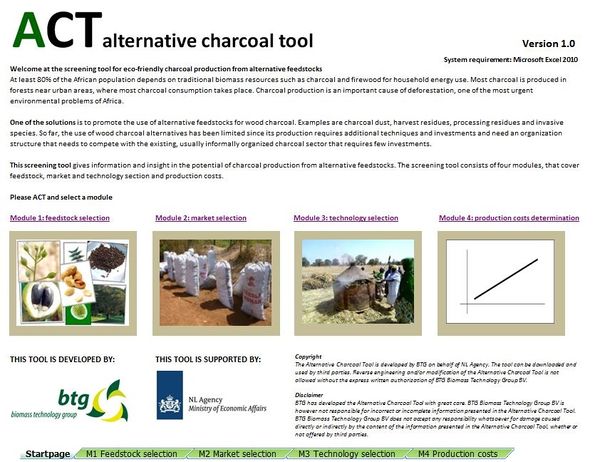Alternative Charcoal Tool (ACT)
Overview
At least 80% of the African population depends on traditional biomass resources such as charcoal and firewood for household energy use. Most charcoal is produced in forests near urban areas, where most charcoal consumption takes place. Charcoal production from wood is an important cause of deforestation, one of the most urgent environmental problems of Africa.[1]
One of the solutions is to make charcoal production and usage more sustainable, e.g. by growing woodfuel plantations, forest management practices, forest and land tenure policies, improved carbonization efficiency, and efficient end user technologies.[2]
Another solution is to promote the use of alternative feedstocks for wood charcoal. However, the use of wood charcoal alternatives has been limited so far, since its production requires additional technologies and investments that need to compete with the usually informal charcoal sector.
The Alternative Charcoal Tool
The Alternative Charcoal Tool (ACT) gives small and medium enterprises, policy makers as well as NGOs in developing countries insight in the potential of charcoal production from alternative feedstocks on a regional or country level. Examples are charcoal dust, harvest residues like cotton stalks, processing residues and invasive species.[3]
The tool has been developed by Biomass Technology Group BV (BTG) on behalf of NL Agency.
Being an interactive excel tool, the ACT...
- Provides quick guidance for assessing business case opportunities
- Supports the design and implementation of programmes and projects
The Alternative Charcoal Tool consists of four modules, namely:
Feedstock Selection
The first module focuses on the question which feedstocks are more likely to become an alternative to wood charcoal.
In a first step, alternative feedstocks are assessed by several questions, e.g. the particle size, the moisture content, and if there is already some experience in using this feedstock for charcoal production. These questions form indicators for different themes such as sustainability, charcoal production, logistics, quality and price of final product, etc. Depending on the answers a score is given showing the suitability of the feedstock.
In a second step, alternative feedstocks are compared based on their availability on the national level. To this end, data from FAO and residue-to-crop factors are used for a rough calculation.
Market Selection
Besides its usage as household cooking fuel, charcoal is also used in small and medium enterprises and social institutions for space and water heating or as burning fuel for blacksmiths. Urban middle classes use it also as barbeque fuel.
Module two helps to define the market and main quality of the charcoal substitute. In a second step additional user requirements, e.g. heat output, smoke release or burning time can be selected that are considered important. The ACT gives recommendations how to deal with these quality requirements.
Technology Selection
This module first gives a recommendation for technical concept of charcoal production. In a second step it supports the selection of a carbonization technology by presenting different kilns and their technological specifications. Thirdly, information about different densification technologies is presented and the appropriate technique can be selected. Last but not least, the ACT provides information about binders, which are needed to form briquettes, and supports its selection.
Short videos show practical examples of carbonization and densification technologies and densification , such as carbonization of cotton stalks in Mali, charcoal briquetting in India or
Production Costs
The production costs of alternative charcoal consist of several factors like feedstock, binder, labor, transport, and carbonization and briquetting costs. This module gives an overview of the costs based on user defined supply chains. In a first step the production costs are determined. A second step compares fuel prices for firewood, traditional charcoal and alternative charcoal.
Downloads
|
Alternative Charcoal Tool (NL Agency / BTG, excel tool, 2013) This decision support tool gives information and insight in the potential of charcoal production of alternative feedstock. Four modules cover feedstock selection, market selection, technology selection and production costs determination. |
|
Charcoal production from alternative feedstocks (NL Agency, report, 2013) This report provides background information for the Alternative Charcoal Tool, including an overview of alternative charcoal production technologies and a description of three supply chains presented as case studies. The case studies cover the feedstocks charcoal dust, cotton stalks and bamboo. The report shows differences and similarities between different feedstocks in detail. |
|
Making charcoal production in Sub Sahara Africa sustainable (NL Agency, report, 2010) This report assesses the bottlenecks and the possible solutions for making charcoal production in Africa sustainable. |
|
Information in a nutshell, to share and print. |
The tool can be downloaded and used by thirds parties for their own use free of charge. Reverse engineering and/or modification of the ACT is not allowed without the express written authorization of BTG Biomass Technology Group BV.
Further Information
- The Charcoal Project
- Harvest Fuel Initiative
- World Agroforestry Centre: Charcoal briquetting in Nairobi relieves poverty, environmental stresses
- Kenya Charcoal Policy Handbook.pdf Kenya Charcoal Policy Handbook
- Africa’s addiction to charcoal, smallstarter.com
- Document Download: Bamboo Charcoal and sustainable management
- Biochar




















